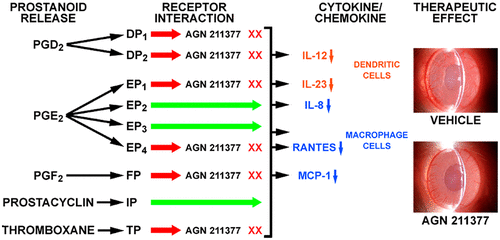当前位置:
X-MOL 学术
›
ACS Pharmacol. Transl. Sci.
›
论文详情
Our official English website, www.x-mol.net, welcomes your
feedback! (Note: you will need to create a separate account there.)
A Second Generation Prostanoid Receptor Antagonist Acting at Multiple Receptor Subtypes
ACS Pharmacology & Translational Science ( IF 4.9 ) Pub Date : 2020-10-26 , DOI: 10.1021/acsptsci.0c00118 David F Woodward 1 , Jenny W Wang 1 , Clayton S Spada 1 , Robert W Carling 2 , Jose L Martos 2 , Simon Pettit 2 , Jussi Kangasmetsa 2 , L David Waterbury 3 , Matthew Lawrence 4 , Wenzheng Hu 4 , Neil J Poloso 1
ACS Pharmacology & Translational Science ( IF 4.9 ) Pub Date : 2020-10-26 , DOI: 10.1021/acsptsci.0c00118 David F Woodward 1 , Jenny W Wang 1 , Clayton S Spada 1 , Robert W Carling 2 , Jose L Martos 2 , Simon Pettit 2 , Jussi Kangasmetsa 2 , L David Waterbury 3 , Matthew Lawrence 4 , Wenzheng Hu 4 , Neil J Poloso 1
Affiliation

|
It has previously been reported that a prototypical compound (AGN 211377), which blocks pro-inflammatory prostanoid receptors (DP1, DP2, EP1, EP4, FP, TP) and leaves open IP and EP2 receptors so that their anti-inflammatory properties could be exerted, produced superior inhibitory effects on cytokine release from human macrophages compared to cyclooxygenase (COX) inhibitors. This favorable activity profile translated into animal studies, with AGN 211377 exceeding the level of inhibition afforded by COX inhibition. AGN 211377 was not, however, a practical drug candidate, having poor bioavailability and cost of goods concerns. Compound 1 (designated AGN 225660) represents a second-generation compound with an entirely different “druggable” core structure. Such a dramatic change in chemical scaffold created uncertainty with respect to matching the effects of AGN 211377. AGN 225660 inhibited RANTES, IL-8, and MCP-1 secretion by at least 50%, from TNFα activated human macrophages. Although AGN 225660 reduced TNFα-evoked MCP-1 release from human monocyte-derived macrophages, it increased LPS-induced MCP-1 secretion (up to 2-fold) from human monocyte-derived dendritic cells. However, AGN 225660 inhibited the release of IL12p 70 and IL-23 from human monocyte-derived dendritic cells stimulated by LPS by more than 70%. This effect of AGN 225660 was reproduced in part by the prototype compound AGN 211377 and a combination of selective DP1, EP1, EP4, FP, and TP antagonists. These findings suggest important effects on T cell skewing and disease modification by this class of therapeutic agents. AGN 225660 exhibited good ocular bioavailability and was active in reducing ocular inflammation associated with phacoemulsification surgery, LPS, and arachidonic acid induced uveitis.
中文翻译:

作用于多种受体亚型的第二代前列腺素受体拮抗剂
先前已有报道称,一种原型化合物 (AGN 211377) 可阻断促炎性前列腺素受体 (DP 1、DP 2、EP 1、EP 4、 FP、TP) 并打开 IP 和 EP 2受体,从而使其抗-与环氧合酶 (COX) 抑制剂相比,可以发挥炎症特性,对人巨噬细胞的细胞因子释放产生更好的抑制作用。这种有利的活性特征转化为动物研究,AGN 211377 超过了 COX 抑制提供的抑制水平。然而,AGN 211377 不是实用的候选药物,具有较差的生物利用度和商品成本问题。化合物1(指定为 AGN 225660)代表具有完全不同的“可成药”核心结构的第二代化合物。化学支架的这种戏剧性变化在匹配 AGN 211377 的作用方面产生了不确定性。 AGN 225660 从 TNFα 激活的人类巨噬细胞中抑制了至少 50% 的 RANTES、IL-8 和 MCP-1 分泌。尽管 AGN 225660 减少了人单核细胞衍生的巨噬细胞中 TNFα 诱发的 MCP-1 释放,但它增加了人单核细胞衍生的树突细胞中 LPS 诱导的 MCP-1 分泌(高达 2 倍)。然而,AGN 225660 抑制 IL12p 70 和 IL-23 从 LPS 刺激的人单核细胞衍生的树突细胞中释放超过 70%。AGN 225660 的这种效果部分地由原型化合物 AGN 211377 和选择性 DP 1、EP的组合重现。1、EP 4、FP和TP拮抗剂。这些发现表明此类治疗剂对 T 细胞偏斜和疾病修饰具有重要影响。AGN 225660 表现出良好的眼部生物利用度,并能有效减少与超声乳化手术、LPS 和花生四烯酸诱导的葡萄膜炎相关的眼部炎症。
更新日期:2020-12-12
中文翻译:

作用于多种受体亚型的第二代前列腺素受体拮抗剂
先前已有报道称,一种原型化合物 (AGN 211377) 可阻断促炎性前列腺素受体 (DP 1、DP 2、EP 1、EP 4、 FP、TP) 并打开 IP 和 EP 2受体,从而使其抗-与环氧合酶 (COX) 抑制剂相比,可以发挥炎症特性,对人巨噬细胞的细胞因子释放产生更好的抑制作用。这种有利的活性特征转化为动物研究,AGN 211377 超过了 COX 抑制提供的抑制水平。然而,AGN 211377 不是实用的候选药物,具有较差的生物利用度和商品成本问题。化合物1(指定为 AGN 225660)代表具有完全不同的“可成药”核心结构的第二代化合物。化学支架的这种戏剧性变化在匹配 AGN 211377 的作用方面产生了不确定性。 AGN 225660 从 TNFα 激活的人类巨噬细胞中抑制了至少 50% 的 RANTES、IL-8 和 MCP-1 分泌。尽管 AGN 225660 减少了人单核细胞衍生的巨噬细胞中 TNFα 诱发的 MCP-1 释放,但它增加了人单核细胞衍生的树突细胞中 LPS 诱导的 MCP-1 分泌(高达 2 倍)。然而,AGN 225660 抑制 IL12p 70 和 IL-23 从 LPS 刺激的人单核细胞衍生的树突细胞中释放超过 70%。AGN 225660 的这种效果部分地由原型化合物 AGN 211377 和选择性 DP 1、EP的组合重现。1、EP 4、FP和TP拮抗剂。这些发现表明此类治疗剂对 T 细胞偏斜和疾病修饰具有重要影响。AGN 225660 表现出良好的眼部生物利用度,并能有效减少与超声乳化手术、LPS 和花生四烯酸诱导的葡萄膜炎相关的眼部炎症。











































 京公网安备 11010802027423号
京公网安备 11010802027423号